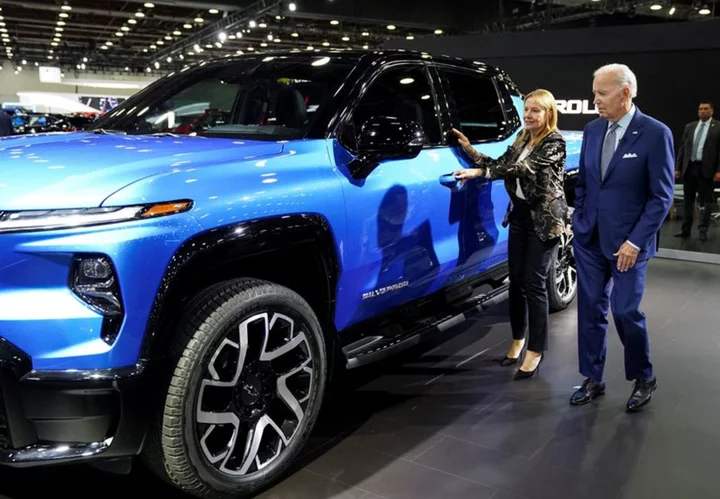By Paul Lienert and Joseph White
DETROIT General Motors has signaled in a series of recent announcements on plant retoolings that it plans to keep its largest and most profitable combustion trucks and SUVs in production longer than expected - another 10 to 12 years, according to analysts and suppliers.
This should enable the automaker to reap tens of billions of dollars in additional profit, according to Reuters estimates, before it shifts completely to zero-emission electric vehicles in 2035.
GM in November 2021 said it would switch to an all-electric fleet by 2035. It never said when exactly it would stop producing gasoline-powered trucks and SUVs, though suppliers and analysts expected it would be well before 2035.
The longer timeline for churning out combustion trucks and SUVs, and the potential to harvest $50 billion or more in profit over that period, is the real news behind GM's announcements this past week that it will spend nearly $3 billion to retool and upgrade several North American plants. Details on the timing and potential profit have not previously been disclosed.
GM told Reuters on Monday that it does not comment on future product plans.
The U.S. automaker over the past week announced investments in five plants in the United States and Canada, without providing details on products or timing, other than to say the plants will continue to build full-size internal combustion engine (ICE) vehicles.
The GM plants include two in Flint, Michigan, and one plant each in Arlington, Texas; Fort Wayne, Indiana; and Oshawa, Ontario.
GM's strong signal that it intends to keep full-size ICE vehicles in production “for years to come,” as one executive said last week, should be well-received by investors and the United Auto Workers. GM and the union will begin negotiating a new multi-year labor agreement this summer. The future of combustion vehicle-related jobs is a central concern for the union.
GM executives have made it clear that ICE vehicles will play a critical role in the company's portfolio for the foreseeable future.
In April, Chief Financial Officer Paul Jacobson told investors: “We're strategically transitioning the business, while at the same time leveraging our important ICE portfolio with new and refreshed products, driving continued robust demand for our vehicles.”
GM executives also have acknowledged it could be years before the company's new EVs begin to attract enough customers to match the profit from petroleum-fueled Chevrolet Silverado pickups and Cadillac Escalade SUVs.
PROJECTED PROFIT
Ford Motor faces a similar situation. CEO Jim Farley in May said the company's electric vehicles may not reach cost parity with Ford's combustion vehicles until the second and third generations of EVs arrive between 2025 and 2030, and has indicated Ford's combustion trucks could remain in production well beyond then.
In the meantime, profit from ICE vehicles continues to roll in.
Last year, GM’s average per-vehicle earnings before interest and taxes on all of its trucks and SUVs was $10,678, as calculated by Benchmark auto analyst Michael Ward, based on GM’s SEC filings.
Using that metric, GM stands to earn up to $7.5 billion a year in pretax profit on its full-size combustion trucks and SUVs, based on AutoForecast Solutions’ estimates for production at the Flint, Fort Wayne, Arlington and Oshawa plants through 2035.
The Arlington plant, which is now scheduled to build GM’s full-size combustion SUVs like the Tahoe, Suburban and Yukon through 2034, is “the most profitable auto plant in the world,” according to Ward.
“Arlington produced 345,000 units in 2022, and by our estimate generated about $25 billion in revenue and $4 billion in EBIT – or about 30% of total company EBIT,” Ward told Reuters.
Flint and Oshawa are expected to build a combined 360,000 heavy-duty pickups a year through 2035, according to AutoForecast Solutions (AFS). Using GM’s EBIT data as calculated by Ward and Benchmark, those two plants could generate $3.8 billion a year in pretax profit.
GM does not disclose its wholesale prices to dealers or its gross margins. A 2024 GMC Sierra 3500 HD Denali Ultimate retails for up to $107,000 and more, while a 2023 Cadillac Escalade ESV V-Series can fetch $160,000 or more, according to GM dealers’ internet ads.
Suppliers have been told that GM plans to begin production of its redesigned Chevrolet Silverado HD and GMC Sierra HD pickups in mid-2027 in Flint, with the updated Silverado HD going into Oshawa at the same time.
GM plans to run its heavy-duty combustion pickups at both plants until 2035, according to AFS, which provides data and analysis to vehicle manufacturers and suppliers.
GM scrapped an earlier plan to build electric versions of its heavy-duty pickups, according to AFS.
Meanwhile, the company is preparing to launch the next-generation Tahoe, Suburban, Yukon and Yukon XL at Arlington in early 2028, AFS said.
The automaker will gradually reduce annual production of its big SUVs in Arlington as it begins to introduce new electric companions, starting around mid-decade. By 2030, AFS forecasts Arlington production could drop to around 200,000 vehicles, which could still produce at least $2 billion in pretax earnings.
(Reporting by Paul Lienert and Joe White in Detroit; Editing by Matthew Lewis)

